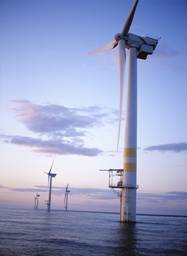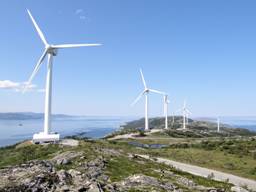Background
The fastest growing alternate energy source is wind power. It has made huge strides in the last 10 years, both nationally and internationally. Predominantly, the big impact of wind turbines is in the large, utility scale, installations…machines capable of producing megawatts (MW) of power. These are physically large machines. The steel pole upon which the wind turbine generator and propellers are installed may be on the order of 200-250 feet tall. Atop this sits propellers whose tip-to-tip measurement can be as large as a football field. Large propeller areas are required because while the planet’s wind energy is free, it is quite dispersed, and must be collected over a rather large swept rotor area. Depending upon design, a utility size wind turbine is generally capable of producing 765 kW-2.5 MW….with new prototypes and designs aiming for the 4-6 MW size range.
To run effectively and economically, wind turbines should be located in areas where the wind blows, on a sustained basis, at least 12 miles per hour; and ideally, 20 miles per hour or greater. The more a wind turbine operates, and the higher the wind speed, the cheaper the electricity it generates. In unusually high wind speeds, large wind turbines safely shut down to avoid damage.
Wind turbines can be clustered over large open land areas generally known as wind farms. Here the turbines can be spaced apart by 10-20 rotor diameters so the machines will not interfere with each other. Turbines are also sometimes located across the ridge line of hills and mountains, or along shore areas near large bodies of water where naturally high wind speeds may result. [See GE wind turbine photos below.] Canyon passes can likewise provide a natural funneling effect of wind speeds.
History of Wind Power Development
Worldwide, in total, there are about 158,000 MW of wind energy now in operation. Currently the U.S. is the leader in wind energy generation, with 35,000 MW of capacity; but because of the huge existing base of conventional electric power generation, 1,000,000 MW already on-line, this currently translates to only about 2-3% or so of all U.S. electric generation being supplied from wind. This may grow quite a bit more as many states are mandating that electric utilities use solar and wind energy technologies in their power generation mix. Here is how U.S wind installation capacity in MW grew since 2005:
2005 9,000
2006 12,000
2007 17,000
2008 25,000
2009 35,000
As we might expect, the windy plains states tend to dominate the wind turbine rankings with wide open spaces, little native population, and relatively good wind conditions. Large machines and wind farms can be built there. However, there will be costs to get this energy out to consumers who do not live nearby, or where convenient connections to an existing power grid may not be available.
Few Atlantic coast states, where a great deal of the nation’s electric load resides, can take advantage of wind power in a big way. It will be a challenge to bring wind power to these energy hungry states, or to find sites within those states where some modest wind energy farms may be constructed. It is possible we may see wind turbines located off coastal states that can make use of often strong and steady wind speeds several miles offshore. In mid-October, Google announced an almost 38% equity investment in a revolutionary $5 billion transmission system for interconnecting Atlantic Seaboard offshore wind turbines. This 350-mile underwater backbone would first provide a superhighway to bring power from the Virginia area to New Jersey; and then allow soon thereafter for offshore wind turbines to conveniently connect into the electricity superhighway as well. Permission for the off-shore wind farms still must be obtained from the coastal states.

GE is one of the world’s leading wind turbine suppliers, with over 13,500 wind turbine installations worldwide, ranging from 1.5 to 4.0 megawatts in size. Caithness Energy LLC and GE are teaming up at the Shepherds Flat Wind Project in Oregon to establish a massive 845-megawatt wind-powered energy generating facility located immediately south of the Columbia River. The wind farm output is enough to provide electricity to 235,000 homes. It will be the constructed between 2010 and 2012 and consist of 338 of GE’s 2.5xl turbines, making it the first of its type to be deployed in North America. The wind facility will be the largest in the world, and avoid 1,215,991 tons of carbon dioxide per year, equivalent to the annual greenhouse gas emissions from 212,141 passenger vehicles.
“There is no substitute for hard work.” 
GE ® and Google® are trademarks owned by GE and Google Inc. and rights related to those marks are reserved.


